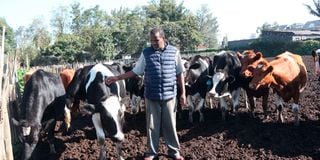Premium
To import or not to import dairy cattle, that is the question

Mr Geoffrey Gitonga at his farm in Lanet, Nakuru County. He has 80 dairy cows. Many Kenyan farmers want to have cows that produce 25-45 litres of milk a day.
Farmers are bombarded with a lot of information for three main reasons; that a majority of them do not have foundational knowledge in animal and crop husbandry, every marketer wants to sell their products and the fact that there no longer exists an organised and reliable public agricultural extension service.
Dairy farmers, particularly, find themselves in a tight spot with lots of information on the internet, with other farmers, in magazines and newspapers and with a variety of service providers.
Most of the information is confusing to the farmers because every purveyor only gives the component that best suits their merchandise or service.
A Friesian cattle breeder will, for example, convey information that Friesians are the highest producers of milk and therefore very profitable.
The breeder will not say that Friesians have the lowest butter fat content of milk and their milk is at times rejected by consumers who say it is possibly adulterated with water.
Adulteration is a technical term that means a product has added materials to benefit the seller illegally.
The Friesian breeder will also not tell buyers that the animals are heavy feeders.
Their high milk volume benefit, therefore, is annulled by the heavy cost of feeds.
Jersey breeders would publicise the high butter fat content of milk and lower feed consumption compared to the other dairy cattle.
They will conveniently stay tight-lipped on the three main disease challenges of the breed.
Jerseys are more likely get mastitis, ketosis and milk fever than other breeds.
Mastitis is infection of the udder while ketosis is metabolic poisoning due to low supply of carbohydrates.
Milk fever is caused by low blood calcium, especially during late pregnancy or soon after calving. The animal is unable to stand.
Jerseys have a natural deficiency of vitamin D receptors in their intestines, lowering the rate and quantity of calcium absorption into the blood.
I have followed discussions of farmers in many forums and found the advice they give one another ranges from useful to hilarious and even disastrous.
In one forum, a farmer posted a photo of the pasty dung voided by her cow that morning.
The dung contained a lot of blood and she wondered what action to take.
One farmer said the cow must have undergone rectal pregnancy diagnosis and it would be fine after some time.
Another said it must have been inappropriately mated by an overzealous bull!
Yet another said the farmer should inject the cow with tetracycline. Another advised our farmer to give her cow salt water mixed with Magadi soda.
I advised the farmer to call a vet immediately. A million and one things could have gone wrong with the cow.
A thorough clinical examination by a doctor was necessary to diagnose the problem and treat the animal appropriately.
I cautioned the farmer that a delay could lead to rapid deterioration and put the cow’s life in danger. I had in mind an enterohaemorrhagic bacterial infection that, unchecked with prompt treatment, could easily spread to the blood and cause death.
Over the last three weeks, a number of farmers have asked me whether it is advisable to source dairy cattle locally or import them.
They said they had been advised by other farmers to import cows because local breeds are of poor quality.
Incidentally, all the farmers told me they wanted cows that could produce 25 to 45 litres of milk a day.
My answer was that what they are looking for what exists in Kenya.
However, they needed to understand the breeds of cattle that could attain their production targets.
Jerseys and Guernseys were obviously out of question. Their top production is normally below 25 litres daily. That would only leave , the farmers with Ayshires and Friesians. I advised the latter because they are readily available.
Kenya has good dairy genetics spread all over high rainfall areas, especially Mt Kenya and the Rift Valley.
I explained that the main challenge with Kenyan dairy cattle is not their genetic make-up but poor production environment.
In the course of my practice, we have selected dairy cows from farmers in very poor condition and low production but with very good genetics. When the cows are rehabilitated and served with high quality semen, they give high daily milk yields and their heifers also produce highly.
On one farm, cows that produced five litres per day at the point of buying gave 26 to 56 litres after rehabilitation.
Their heifers produced more than 30 litres of milk daily.
The production performance of a cow depends on the interaction of the animal’s genetics and its environment.
Trained and experienced livestock assessors and farmers can determine dairy cattle with good genetics by considering the observable characteristics against the breed standard.
Environment in breed performance refers to all production parameters except genetics.
These include nutrition and feeding, physical environment and diseases.
I recall one time a farmer bought cows from Nakuru that I confirmed were of good dairy genetics.
They were producing on average 40 litres of milk daily. By the time they completed two weeks on his farm in Nairobi, the cows were producing eight litres due to poor housing, watering and feeding.





